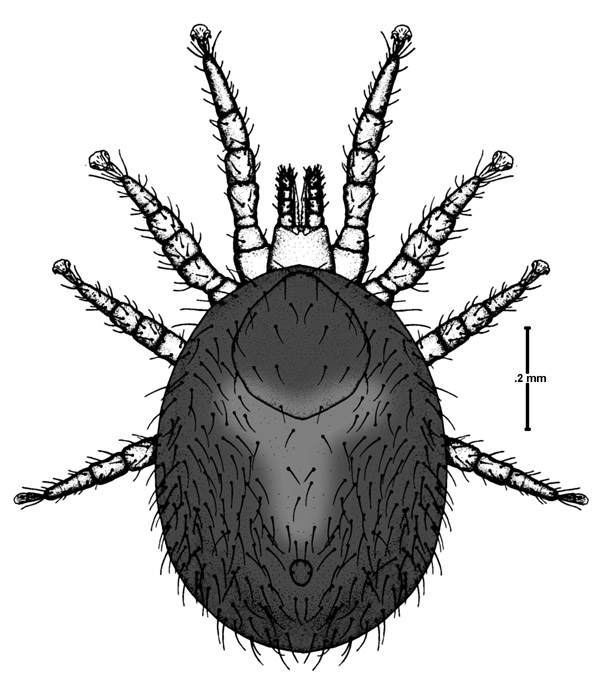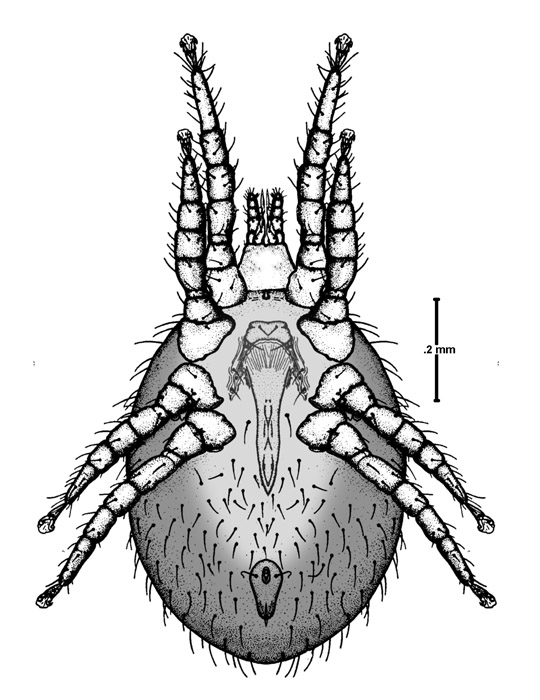The Life History of Snake Mites
The Life History of Snake Mites
There are few statements more disturbing to a keeper than: "You've got snake mites in your collection." The snake mite, Ophionyssus natricis, is an arachnid ectoparasite of snakes. These mites suck snake blood, they annoy snakes, they are potential vectors for the transmission of serious diseases, and they can be difficult to eliminate when they have been introduced to a captive snake collection.
Snake mites have been spread worldwide by herpetoculture. It's not known with certainty where they originated or which snake species are their natural hosts. Some authorities propose an African origin for snake mites and ball pythons as a possible natural host. Much of the following information on the life history of mites is summarized from the excellent work by Camin (1953).
Snake mites have five life stages: egg, larva, protonymph, deutonymph, and adult. Each of the three intermediate life stages is shed once to become the next life stage. Ideal environmental conditions for all life stages of snake mites are temperatures of 75 to 85 degrees F (23 to 29.5 degrees C) and relative humidity of 70 to 90 percent. Average longevity is affected by relative humidity and temperatures, and the period of development of the nymphal stages and the length of adult life are greater at lower temperatures. The development and survivorship of all life stages of mites are negatively affected by unfavorable environmental conditions. All life stages are apparently killed by exposure to temperatures in excess of 105 degrees F (38 degrees C) or below 35 degrees F (1 degree C) for periods of several days.
Snake mites drown when they are wet, and they desiccate at levels of humidity below 20 percent. At the temperatures of most snake collections, the complete life cycle of the snake mite can be completed in 13 to 19 days. At cooler temperatures, some individuals may live up to 40 days.
Female mites lay one or two dozen eggs at a time and may lay 60 to 80 eggs in their life. The eggs adhere to the surfaces on which they are laid. Eggs are rarely laid on the snake hosts of the adult mites. They are usually laid somewhere in the enclosure, sometimes high in the cage. Whenever possible, female mites choose to lay eggs in dark, humid places. Mite eggs may be laid on the bodies of large snakes, particularly boas and pythons, usually in the space around the eye or under the anal scale. Eggs hatch in one day in ideal conditions, and at cooler temperatures they may take up to four days to hatch.
There is a common belief among keepers that mite eggs in some conditions may remain viable for extended periods. While this has been documented for some species of ticks, Camin's research on mites found no evidence to support this belief.
The larval stage lasts one or two days. The larvae are pale white, almost invisible to the naked eye, nonfeeding, and, although capable of walking, tend to move very little distance from the location of the eggs.
The protonymph stage lasts from three days to two weeks. This stage is mobile and may move considerable distances. Protonymphs are able to detect and are attracted by the smell of snakes. They require a blood meal to metamorphose to the next stage. Unfed protonymphs are pale ivory or yellowish in color, and they are almost invisible to the naked eye. The sharp-eyed, observant keeper may notice pale protonymphs walking across scale surfaces, especially on a snake's head plates. When engorged after a blood meal, protonymphs are dark red, smaller than adult females and not black in color. After full engorgement, protonymphs become active. Typically, they leave their host snakes and travel until they find a dark, humid location in the snake cage, where they shed, 12 to 24 hours after feeding.
It is common to find engorged protonymphs drowned in the water bowls in snake cages, often the first obvious sign of the presence of snake mites in the cage. The observant keeper will notice them sunk to the bottom of the bowl, looking like little flat pieces of pepper that, upon close inspection, are seen to have legs.
The deutonymph stage is soft-bodied, dark red or black in color, nonfeeding, and usually does not move from the location chosen by the protonymph to shed. This stage is rarely found on snakes, the exception being the space around the eyes of large snakes. Deutonymphs shed within 24 hours to become adults.
Adult male mites are smaller than adult females. They range in color from dark yellowish- Adult Female Mite: dorsal viewbrown to dark red to black, depending on whether they are unfed or engorged with tissue fluids or with blood. Interestingly, when adult male mites feed on large snakes, they are always dark yellowish-brown and are rarely observed to contain many erythrocytes (red blood cells), while if they are feeding on smaller snakes they are black and filled with blood. This is likely because the mouth parts of mature males are modified to use in mating and they may not be able to probe as deeply into their hosts as can the protonymphs and adult females. Camin (1953) theorized that on large snakes, the male adult mites apparently cannot reach the deeper blood capillaries and feed predominantly on tissue fluids. A feeding session takes between one and two days to reach engorgement, at which time males release to wander on and off snake hosts as they search for mates. A male may feed several times in its life. In optimal conditions, the life span of adults is 10 to 32 days.
Adult Female Mite: dorsal viewbrown to dark red to black, depending on whether they are unfed or engorged with tissue fluids or with blood. Interestingly, when adult male mites feed on large snakes, they are always dark yellowish-brown and are rarely observed to contain many erythrocytes (red blood cells), while if they are feeding on smaller snakes they are black and filled with blood. This is likely because the mouth parts of mature males are modified to use in mating and they may not be able to probe as deeply into their hosts as can the protonymphs and adult females. Camin (1953) theorized that on large snakes, the male adult mites apparently cannot reach the deeper blood capillaries and feed predominantly on tissue fluids. A feeding session takes between one and two days to reach engorgement, at which time males release to wander on and off snake hosts as they search for mates. A male may feed several times in its life. In optimal conditions, the life span of adults is 10 to 32 days.
Adult females are the big, fat, black mites most noticeable in a major infestation. After shedding they weigh only .05 milligram, but fully engorged they may weigh .75 milligrams. Females mate with males before they take their first blood meal. These matings produce eggs that hatch to become females. If female mites encounter a snake host before mating, they immediately climb on board and begin a feeding session. Males will not mate with engorged females, and these virgin females lay clutches of eggs that hatch to become males. Feeding sessions take four to six days to achieve complete engorgement, after which time the females typically leave the host snake to lay the eggs elsewhere in the enclosure. After a week or so, the females are diminished in size and begin to wander about the cage, looking to encounter a snake and initiate another feeding session. Females feed about three or four times in their adult lives.
 Adult Female Snake Mite: ventral view At 86 degrees F (30 degrees C), gravid engorged female mites looking for a place to lay eggs can travel at a speed of up to 8 inches per minute, potentially 48 feet per hour, and they may travel several hours looking for a good place to deposit eggs. Unfed females are observed to crawl up to a rate of 11 inches per minute. That's 55 feet per hour! Out on a short stroll, mites can travel considerable distances from their host snakes. They easily can pass through the ventilated surface of a cage and travel to another area of a snake collection.
Adult Female Snake Mite: ventral view At 86 degrees F (30 degrees C), gravid engorged female mites looking for a place to lay eggs can travel at a speed of up to 8 inches per minute, potentially 48 feet per hour, and they may travel several hours looking for a good place to deposit eggs. Unfed females are observed to crawl up to a rate of 11 inches per minute. That's 55 feet per hour! Out on a short stroll, mites can travel considerable distances from their host snakes. They easily can pass through the ventilated surface of a cage and travel to another area of a snake collection.
Other hosts
Snake mites usually do not infest mammal species, yet they have been known occasionally to parasitize rodents and humans, taking a blood meal and then moving on (Mader, 1996). Snakes are not known to be parasitized by any of the mite species that commonly parasitize rodents.
Rodents that have been treated with insecticides for mite infestations can be highly toxic to snakes. Over the years we have seen snakes that were poisoned by eating rodents from colonies that were being treated for mites.
Literature Cited
Camin, J. H. 1953. Observations on the life history and sensory behavior of the snake mite, Ophionyssus natricis (Gervais), (Acarina: Macronyssidae). Special Publications Number 10. The Chicago Academy of Sciences, 10: 1-75.
This article from: Pythons of the World, Volume II: BALL PYTHONS: The History, Natural History, Care, and Breeding. Barker and Barker. 2006.
